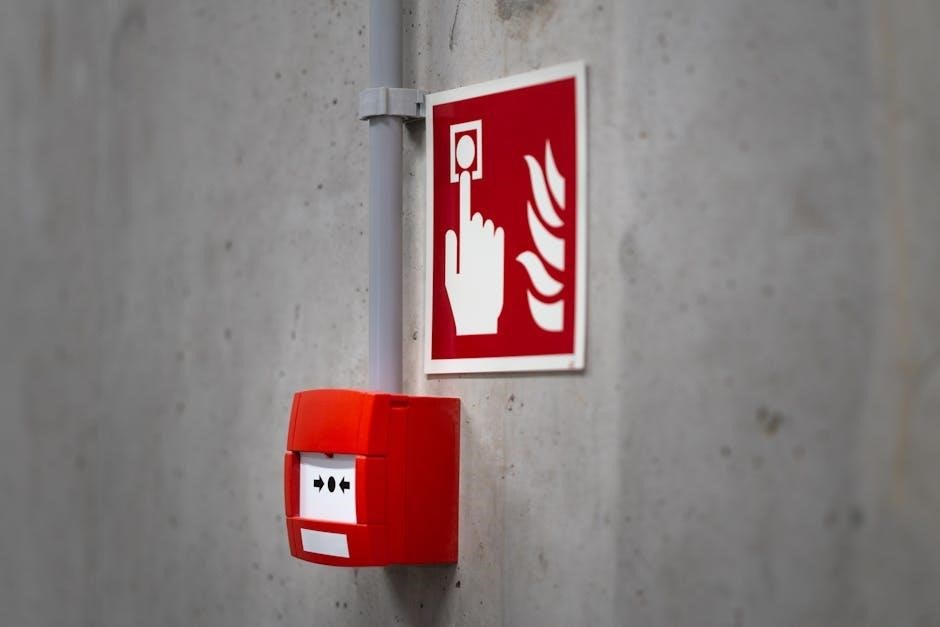Manual Call Points (MCPs) are essential devices in fire safety systems, enabling manual activation of fire alarms․ They are critical for triggering alerts in emergencies, ensuring timely evacuations and protecting lives․ MCPs are typically wall-mounted and designed for easy access, providing a reliable way to signal a fire outbreak․ Their importance lies in their ability to initiate a rapid response, making them a fundamental component of fire safety infrastructure in buildings․ Regular maintenance and compliance with fire safety regulations are vital to ensure their effectiveness․
1․1 Definition and Purpose
A Manual Call Point (MCP) is a device designed to enable individuals to manually trigger a fire alarm in emergency situations․ Its primary purpose is to alert occupants of a potential fire hazard, ensuring timely evacuation and response․ MCPs are typically wall-mounted and feature a simple mechanism, such as a button or lever, for activation․ They are crucial in fire safety systems, as they provide a reliable means of initiating an alarm when a fire is detected․ By allowing anyone to raise the alarm, MCPs play a key role in preventing fires from escalating and protecting lives and property․
1․2 Importance in Fire Safety Systems
Manual Call Points (MCPs) are indispensable in fire safety systems as they provide a direct and immediate way to alert individuals of a fire emergency․ Their importance lies in their ability to ensure a rapid response, which is critical for minimizing damage and saving lives․ MCPs act as a failsafe, complementing automated fire detection systems by allowing manual intervention when necessary․ They are particularly vital in areas where fire hazards are high or where early detection is crucial․ Compliance with fire safety regulations often mandates their installation, ensuring that buildings are equipped to handle emergencies effectively․ MCPs thus form a cornerstone of fire safety infrastructure․

How Manual Call Points Work
Manual Call Points activate fire alarms through a simple mechanism, typically a button press or lever pull, triggering the fire alarm system to alert occupants of potential danger․
2․1 Mechanism of Activation
Manual Call Points activate fire alarms through a straightforward mechanism․ Pressing a button or pulling a lever triggers the device, sending an electronic signal to the fire control panel․ This action initiates the alarm system, alerting occupants to evacuate․ Some MCPs are wireless, using radio frequencies to communicate with the panel, while others rely on hardwired connections․ Once activated, the system sounds alarms and may trigger additional safety measures like sprinklers or lighting․ The mechanism ensures rapid response to emergencies, making MCPs a critical component of fire safety systems․ Regular testing and maintenance are essential to ensure reliable operation․
2․2 Integration with Fire Alarm Systems
Manual Call Points seamlessly integrate with fire alarm systems to ensure comprehensive emergency response․ Upon activation, the MCP sends a signal to the central control panel, which processes the alert and triggers alarms․ Some systems utilize addressable technology, allowing the panel to identify the exact location of the activated MCP․ This integration enhances response efficiency by providing critical information to emergency responders․ Additionally, modern systems may incorporate features like visual alerts or voice messages to ensure clear communication․ Proper installation and configuration are essential to maintain system reliability and compliance with fire safety standards․ This integration ensures that manual alerts are effective and immediate, safeguarding lives and property․

Key Features of Manual Call Points
Manual Call Points are designed for durability, featuring robust materials and tamper-proof mechanisms․ They are highly visible, often with bright colors and clear signage, ensuring easy accessibility in emergencies․ Their simple operation ensures quick activation, while weather-resistant designs suit various environments․ These features enhance reliability and effectiveness in fire safety systems․
3․1 Durability and Design
Manual Call Points are constructed with durable materials, such as high-grade plastics and metals, ensuring longevity and resistance to environmental factors․ Their designs prioritize ease of use and reliability, often featuring tamper-proof mechanisms to prevent accidental activation․ The robust construction withstands heavy use and harsh conditions, making them suitable for both indoor and outdoor installations․ Additionally, their compact and ergonomic designs allow for seamless integration into various architectural settings without compromising functionality․ This focus on durability and design ensures that MCPs remain operational and accessible during critical emergencies, providing a dependable means of initiating fire alarms when needed most․
3․2 Visibility and Accessibility
Manual Call Points are designed to be highly visible and easily accessible to ensure quick activation in emergencies․ They are typically installed at a standard height, making them reachable for most individuals, including those with disabilities․ Bright colors and illuminated features enhance their visibility, even in low-light conditions․ Strategic placement in high-traffic areas, such as near exits or along corridors, ensures they are easily locatable․ Clear pathways to MCPs are essential to prevent obstacles from hindering access․ These design considerations ensure that anyone can quickly and reliably activate the alarm, contributing to timely evacuations and fire response․ Compliance with accessibility standards is crucial for their effectiveness․

Types of Manual Call Points
Manual Call Points are available as conventional and addressable systems․ Conventional MCPs are basic, while addressable versions offer advanced features like precise location identification and smart integration․
4․1 Conventional Manual Call Points
Conventional Manual Call Points are simple, reliable devices used in fire alarm systems․ They operate on a zone-based system, where activating a call point triggers the entire zone’s alarm․ These MCPs are cost-effective and easy to install, making them suitable for small to medium-sized buildings․ They rely on physical wiring and do not require complex programming․ Each zone’s activation alerts the control panel, which then sounds the alarm throughout the premises․ While they lack the precision of addressable systems, conventional MCPs remain a popular choice for their simplicity and durability in basic fire safety setups․
4․2 Addressable Manual Call Points
Addressable Manual Call Points (MCPs) are advanced devices that provide precise location identification during an emergency․ Each MCP has a unique address, allowing the fire alarm system to pinpoint the exact location of the activation․ This feature is crucial in large buildings with multiple zones, enabling faster response times and more efficient evacuations․ Addressable systems are highly scalable and can integrate with other fire safety devices, offering enhanced functionality․ They also support advanced diagnostics, reducing false alarms and ensuring reliability․ These MCPs are ideal for complex fire safety setups, providing detailed information that conventional systems cannot match․

Installation Requirements
Manual Call Points must be strategically placed in accessible locations, ensuring visibility and ease of use․ Installation height and positioning comply with fire safety standards to maximize effectiveness․
5․1 Strategic Placement
Manual Call Points must be installed in strategic locations to ensure quick access during emergencies․ They should be placed near exits, corridors, and assembly points, maintaining a consistent height of approximately 1․2 to 1․5 meters from the floor for easy reach․ Visibility is crucial, so MCPs should be positioned in well-lit areas, free from obstructions․ In large buildings, multiple MCPs are required to cover all accessible routes․ Compliance with local fire safety codes is essential, ensuring that MCPs are spaced appropriately and reachable within a reasonable distance․ Proper placement maximizes their effectiveness in emergency situations, enabling rapid alarm activation and timely evacuation․
5․2 Compliance with Fire Safety Standards
Manual Call Points must comply with fire safety standards to ensure reliability and effectiveness․ These standards often mandate specific design, installation, and maintenance requirements․ For instance, EN 54-11 in Europe outlines strict guidelines for MCPs, including testing and certification․ Compliance ensures that MCPs function correctly during emergencies, providing audible and visual alerts․ Non-compliance can result in legal penalties and compromised safety․ Regular inspections and maintenance are crucial to meet these standards․ Authorities may conduct audits to verify adherence, emphasizing the importance of strict compliance․ By following fire safety regulations, MCPs remain dependable components of fire safety systems, ensuring public safety and legal conformity․

Maintenance and Testing
Regular maintenance and testing of Manual Call Points ensure their functionality and reliability․ This includes visual inspections, mechanical tests, and electrical checks to guarantee optimal performance during emergencies․ Compliance with fire safety standards is crucial to avoid system failures and legal repercussions, ensuring public safety and efficiency․ Proper maintenance routines help prevent false alarms and extend the lifespan of MCPs, making them indispensable in fire safety systems․ Prompt troubleshooting of issues is essential to maintain readiness and ensure rapid response capabilities․ By adhering to maintenance schedules, MCPs remain critical components in fire prevention and evacuation strategies, safeguarding lives and property effectively․
6․1 Routine Inspection Checklist
A routine inspection checklist for Manual Call Points (MCPs) ensures their proper functioning․ Begin with a visual inspection to check for damage, tampering, or wear․ Test the activation mechanism by pressing the button or pulling the lever to confirm the alarm triggers․ Verify that the alarm sound is audible throughout the premises․ Inspect the wiring and connections for any signs of damage or loose links․ Ensure that the MCP is securely mounted and accessible․ Check that the protective cover, if fitted, is functioning correctly․ Test the LED indicators to confirm they illuminate when activated․ Document the inspection results and address any issues promptly to maintain compliance and reliability․
6․2 Troubleshooting Common Issues
Troubleshooting Manual Call Points (MCPs) involves identifying and resolving common faults․ Start by checking the activation mechanism for proper function․ If the alarm fails to trigger, inspect the wiring for damage or disconnections․ Verify that the MCP is connected to the fire alarm control panel․ Address issues like stuck buttons or broken levers promptly․ False alarms can often be traced to faulty wiring or environmental factors․ Test the system after repairs to ensure functionality․ Regular testing and maintenance can prevent recurring issues․ Always refer to the manufacturer’s guidelines for specific troubleshooting steps․ Addressing problems quickly ensures the system remains reliable and ready for emergencies․

Legal and Regulatory Requirements
Manual Call Points must comply with local fire safety laws and regulations․ Regular inspections and adherence to standards ensure compliance, with penalties for non-compliance, emphasizing safety and accountability․
7․1 Fire Safety Laws Governing MCPs
Fire safety laws mandate the installation and maintenance of Manual Call Points (MCPs) in commercial and public buildings to ensure timely fire detection․ In Europe, MCPs must comply with EN 81-28 standards, requiring them to be strategically placed and easily accessible․ In the U․S․, NFPA 72 regulations dictate specific installation heights, locations, and testing frequencies․ Non-compliance with these laws can result in fines and legal action․ Regular inspections and maintenance are essential to meet regulatory requirements, ensuring MCPs function correctly during emergencies․ These laws prioritize public safety, making MCPs a critical component of fire safety systems worldwide․
7․2 Penalties for Non-Compliance
Non-compliance with fire safety regulations regarding Manual Call Points (MCPs) can lead to significant penalties, including fines and legal action․ Authorities enforce strict standards, and violations may result in financial penalties, which can escalate for repeated offenses․ In severe cases, businesses or property owners may face criminal charges if negligence leads to safety breaches․ Additionally, non-compliance can damage reputations and increase insurance costs․ Regulatory bodies, such as fire marshals or local authorities, conduct inspections to ensure adherence to laws․ Failure to maintain or install MCPs correctly can result in enforcement notices or shutdowns until compliance is achieved․ Penalties underscore the importance of prioritizing fire safety measures․

Best Practices for Using Manual Call Points

Ensure proper activation techniques, test regularly, and avoid false alarms․ Train occupants on correct usage, and maintain visibility and accessibility of MCPs to ensure effective emergency response․
8․1 Proper Usage Techniques
Proper usage of manual call points is crucial for effective fire safety․ Always press the button firmly to ensure activation, and avoid touching it unnecessarily to prevent false alarms․ Ensure the call point is easily accessible and visible to all occupants․ Regularly test the device to confirm it triggers the fire alarm system correctly․ Train building occupants on the correct procedure to minimize delays during emergencies․ Familiarize yourself with the call point’s design, whether it requires breaking glass or pressing a button, and ensure it is strategically located near exits or high-traffic areas for quick access․ Proper techniques ensure timely and reliable fire alarm activation․
8․2 Avoiding False Alarms
Preventing false alarms is essential to maintain the credibility of fire safety systems․ Manual call points should be installed in secure locations to avoid accidental activation․ Ensure that occupants are educated on the proper use of MCPs and the consequences of false alarms․ Regular maintenance and testing can identify faulty devices that may trigger unnecessary alerts; Implementing protective covers or key-operated mechanisms can prevent tampering or accidental presses․ Additionally, integrating addressable systems allows for quick identification of false triggers, minimizing disruption․ Training and awareness campaigns can significantly reduce false alarms, ensuring that manual call points are used only in genuine emergencies․ Proper measures safeguard against false activations and maintain system reliability․

Advancements in Manual Call Point Technology
Advancements in manual call point technology include smart MCPs with IoT integration, enabling real-time monitoring and reducing false alarms while enhancing reliability and functionality in modern fire safety systems․
9․1 Smart MCPs and IoT Integration
Smart Manual Call Points (MCPs) integrated with IoT technology represent a significant advancement in fire safety systems․ These devices leverage internet connectivity to enable real-time monitoring, remote diagnostics, and data analysis․ By connecting to a central control system, smart MCPs can provide instant alerts and location-specific information, reducing response times․ IoT integration also allows for automated testing and fault detection, ensuring reliability․ Advanced features include customizable alerts and integration with other building management systems․ This technology enhances situational awareness and streamlines emergency responses, making fire safety more efficient and proactive․ The future of MCPs lies in smarter, connected solutions that prioritize safety and efficiency․
9․2 Future Trends in Fire Alarm Activation
Future trends in fire alarm activation are expected to focus on enhanced connectivity, automation, and intelligent systems․ Advanced technologies like AI-driven analytics and voice-activated systems may revolutionize how alarms are triggered․ Predictive maintenance and self-testing capabilities could become standard, reducing downtime and ensuring reliability․ Integration with smart building systems will likely deepen, enabling seamless communication between MCPs and other safety devices․ Biometric sensors and real-time data analysis could also emerge, providing faster and more accurate emergency responses․ These innovations aim to improve safety, reduce false alarms, and create a more proactive approach to fire safety management in modern buildings․

